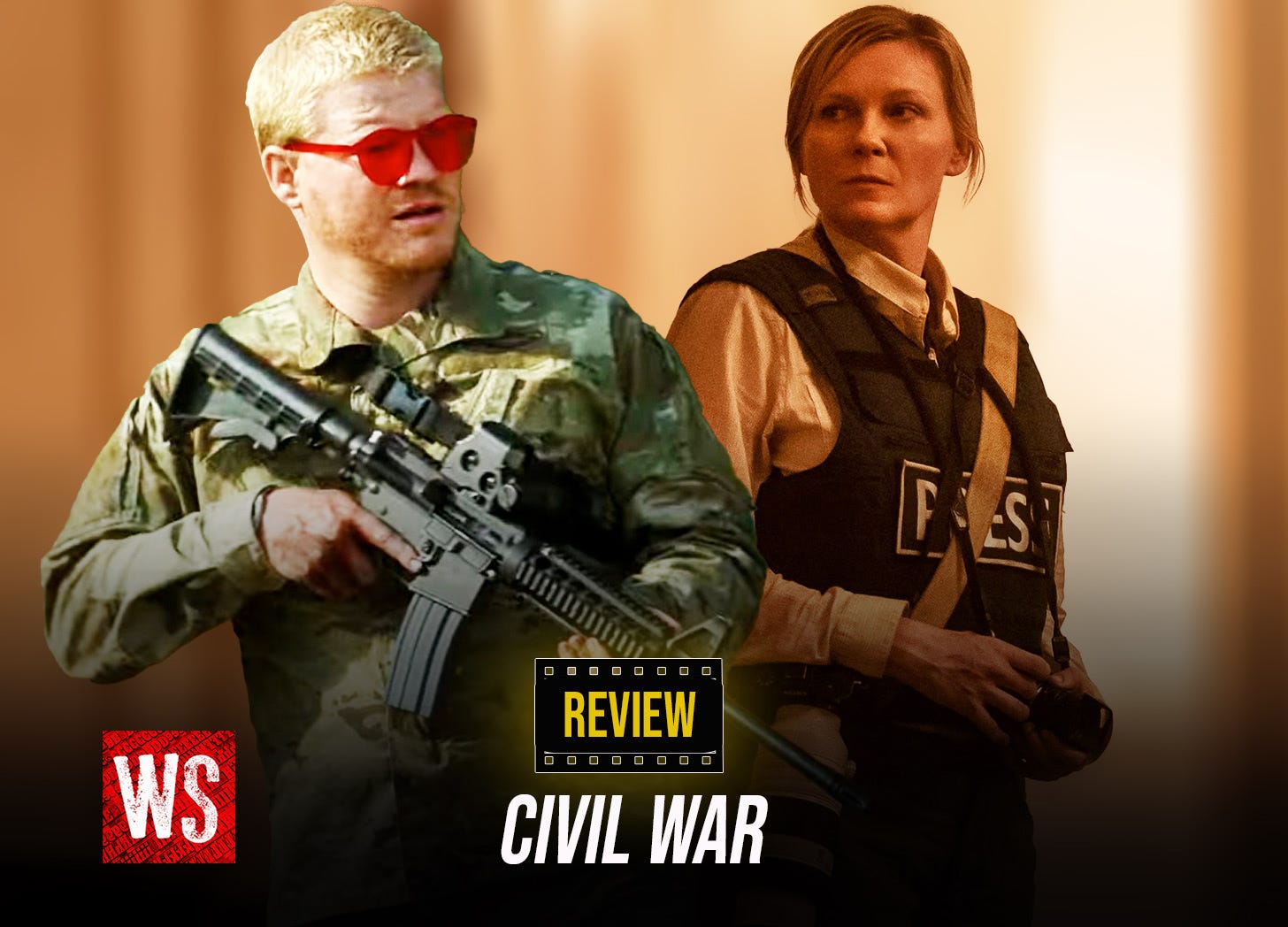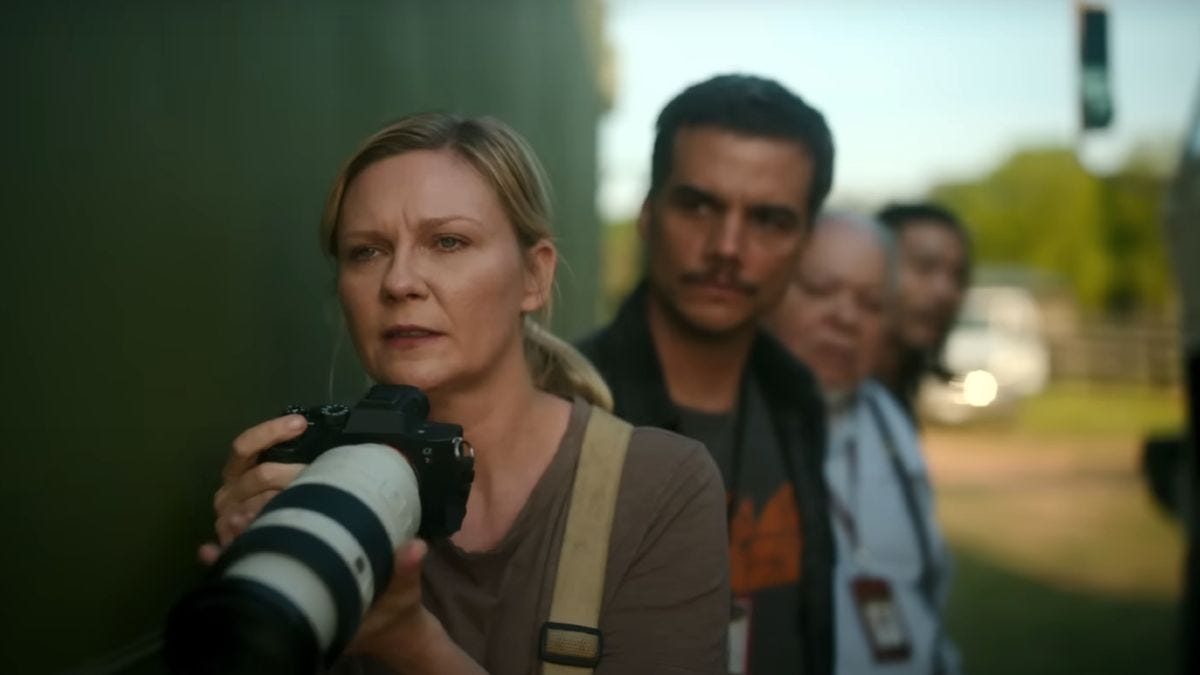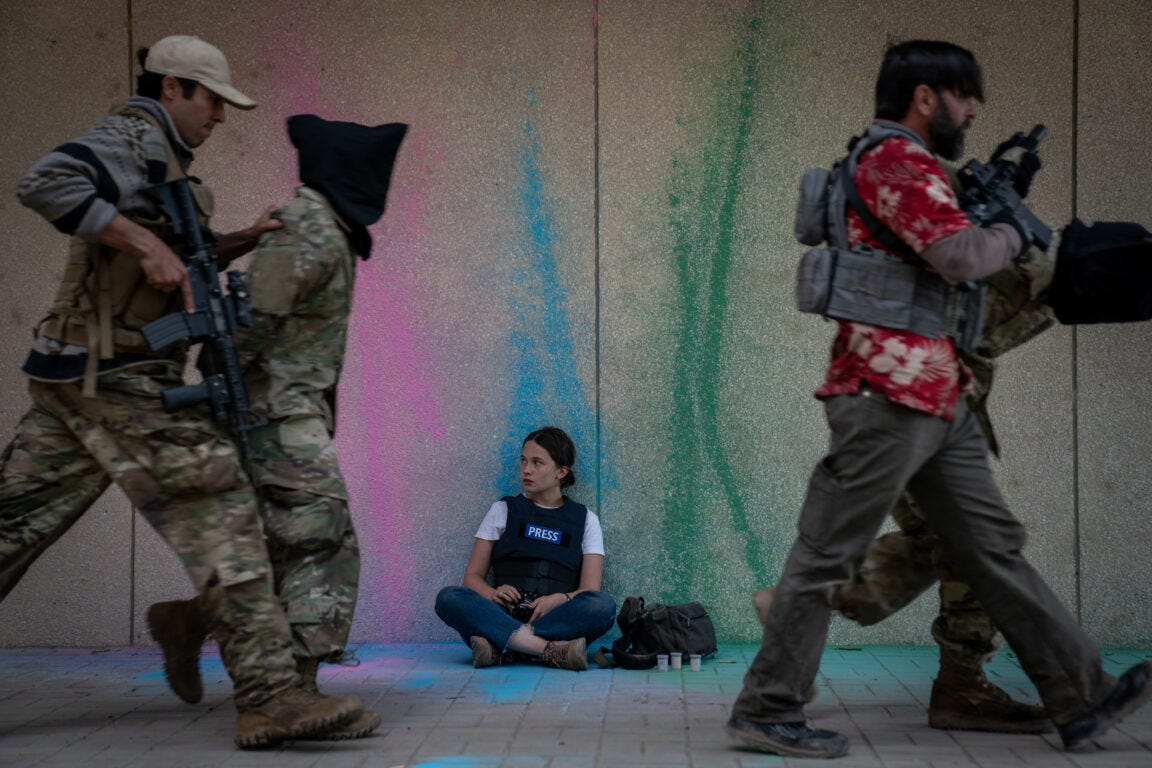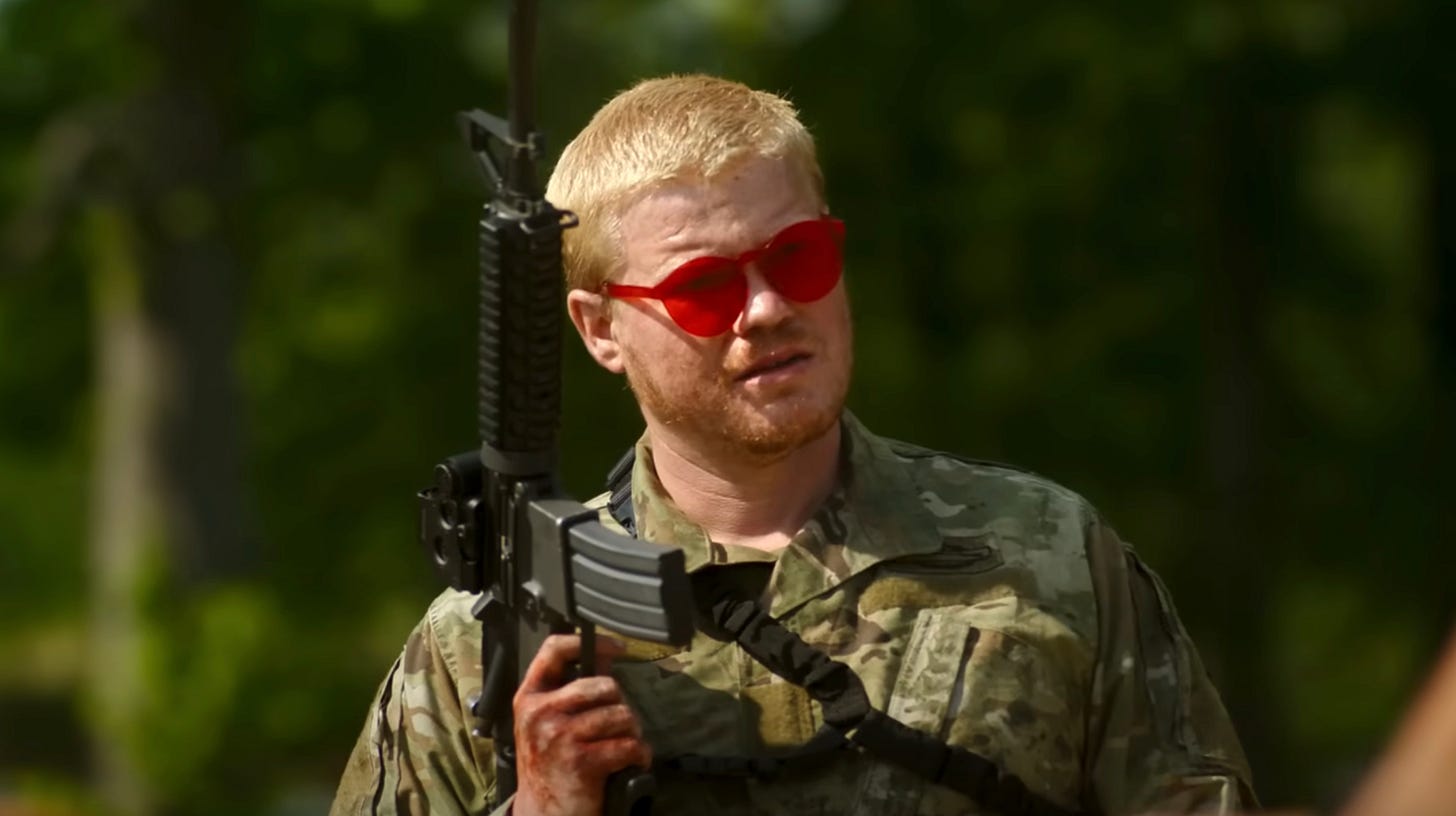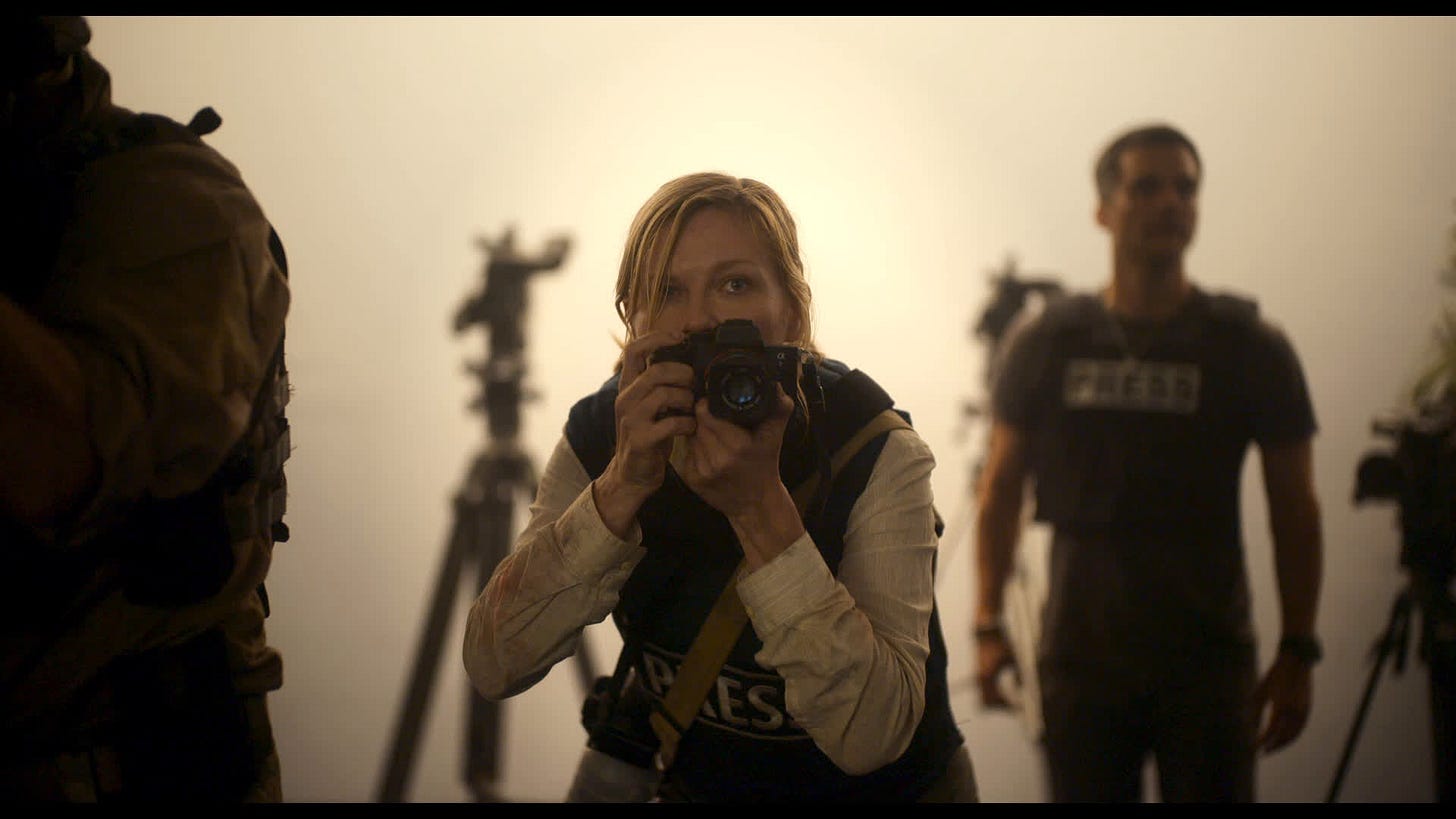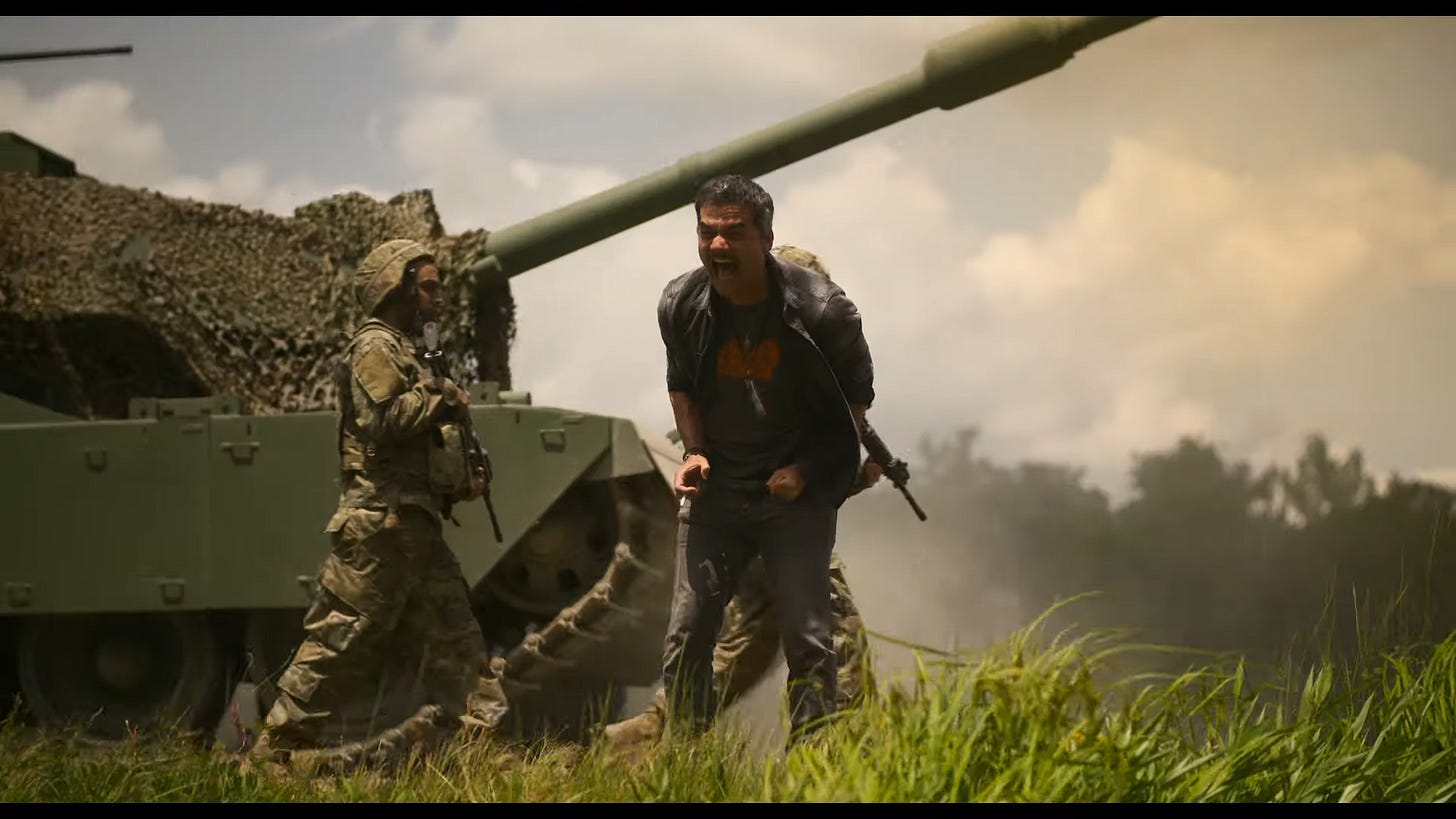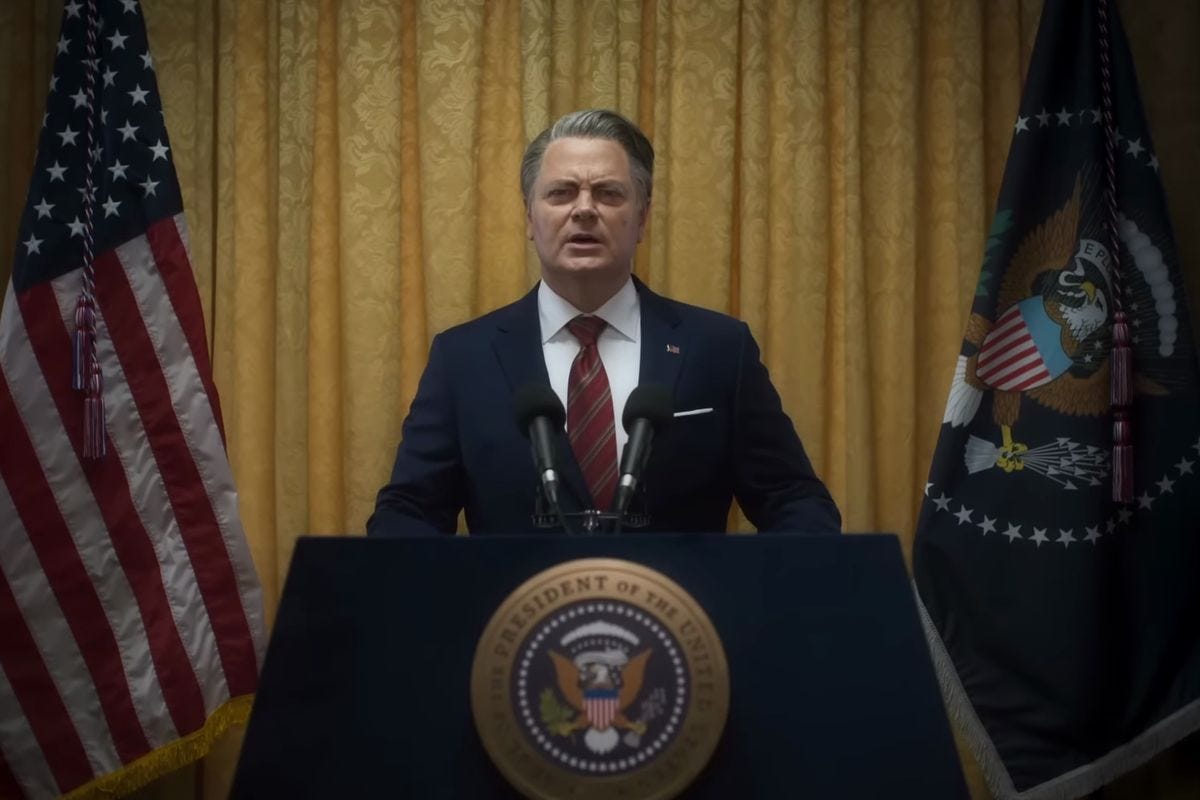Review: Civil (Silly) War
We don't need your Civil War...but it sure does look and sound pretty
As a fan of writer/director Alex Garland, Civil War always seemed like an odd one. Garland is no stranger to pushing boundaries or exploring strange material (see: The Beach, Ex Machina, Annihilation, Men), but aside from the purposely “triggering” imagery of the trailer, particularly the Lincoln Memorial getting hit with a Javelin missile, amongst numerous other “flyovers” of buildings burning, while military aircraft hover about, Civil War always felt somewhat foreign to me. I’ll explain, but let’s talk about what this movie actually is, from a narrative standpoint, first and foremost.
Civil War takes place somewhere in the near future, where both California and Texas have seceded from the Union of The United States of America (calling themselves the Western Front) thus starting a “Civil War”. The nameless President is played by none other than Ron Swanson Nick Offerman, and offers no political affiliation in terms of Democrat or Republican. The opening of the film has him giving a speech that eludes to an inevitable victory, laying out how both California and Texas will be welcomed back into the Union once their leadership surrenders.
It seems like the war has been going on for a bit, although not long. Maybe a few years, as there is far too much stability portrayed. In reality, without food, resources, and supply lines for all 50 states, it would be chaos in the streets and there would be a hell of a lot more rioting, looting, and violence if this thing were real. I mean, did you see people going after toilet paper during Covid lockdowns? Now, imagine the country is in an actual Civil War. Yeah. Exactly.
Enter Kirsten Dunst as a renowned photojournalist named Lee who looks perpetually burned out and dispassionate of her trade, even though she’s supposed to be a big shot journo. While in New York, where the WF have seemingly made their way up the East Coast to fight there (man, Cali and Texas have got some serious military resources, eh?), Lee teams up with Joel (Wagner Moura) and Sammy (Stephen McKinley Henderson), as well as an aspiring photojournalist named Jessie, played by Cailee Spaeny, intent on interviewing The President in Washington D.C.
Henderson's Sammy is meant to be the elder journalist who is past his prime but doesn’t know any other way to live. Moura’s Joel is simply obnoxious, playing it cool and jittery as a kind of “war junkie” reporter (although I never saw him actually do any kind of collecting and transmitting of information), while Spaeny shows the most personality as someone trying to find her footing in the trade. Sadly, the group doesn’t create an interesting dynamic at all, with most scenes focused on them talking arbitrarily, looking out the window at “shocking” scenes of America in a zombie apocalypse-like state, complete with a burning building here and there, as well as abandoned military vehicles and equipment scattered about.
You would think they’d discuss something of import, something about journalism, about America, about the war (or war in general), about politics, or anything, but Civil War skirts every single opportunity to say anything…at all. Hell, it could’ve been a great road movie, as it seems to be trying to do, but road movies usually reveal characters and give them arcs. Not so here.
At one point, the group integrates with a squad of WF soldiers battling Federal troops in a city setting. The WF soldiers are, of course, wearing Hawaiian shirts and body armor, looking every bit the mock-up stereotype of right-wing soldier bros, while Federal Forces are in full battle rattle uniform. It stays this way until the end, when suddenly the WF is now in full battle rattle and operating like a standard military unit, not like a bunch of ultra MAGA gun bros storming The Capitol. No reasoning is given, because why would it be? Nothing else makes sense, so why should uniformity?
Throughout each incident, there are black and white still frames shown, capturing what Dunst and Spaeny are shooting. It’s clever enough at first but becomes a bit grating as it progresses. But, hey, this IS about journalism or whatever, right?
Visually, Civil War is a beauty. Garland captures a ton of war-torn footage amidst the idyllic Americana background, which is sure to ruffle the feathers of the easily triggered. Bodies are dumped into a mass grave on a sunny day with blue skies and birds chirping. Smoke billows into the sky in otherwise sprawling cityscapes, and there’s even a sequence where the journalists drive through a forest fire, a scene that seems to exist only to show how pretty the fire sparks look in macro slow motion.
The sound design is also quite good, with plenty of gunshots, explosions, and aircraft zipping by to get the blood pumping of all the action junkies. The problem? Well, the action doesn’t really mean anything. The stakes? The country, I guess, but you don’t even know who to root for. Perhaps that’s also the point, but that’s pretty ambiguous for a movie Garland wants us all to be appalled and shocked by. If we knew anything about the actual conflict outside of the bare-bones basics, then perhaps there would be some sense of anxiety over the outcome. As it is, there’s just nothing to get excited (or upset) over, as it’s just a bunch of war porn.
The scene that most will be talking about is the one with Jesse Plemons as a WF Soldier (or is he? The uniforms could suggest he could be on either side) that’s supposed to be the embodiment of a left-wing fantasy version of an ignorant, racist, gun-toting incel. It’s understood that journalists are killed on site, a directive from the federal government (not the WF), so it already upends the argument that this is some ultra-right-wing fantasy. I mean, the left is supposed to be a supporter of journalists, no? Ah, it’s all too much. Don’t feel bad if you can’t make heads or tails of it, though, as Civil War trades on stereotypes like candy.
The “Plemons Scene” as I’ll call it, has the actor (in see-through red shades, which are surely issued to all troops in uniform in this universe) holding two of our journalist characters hostage, with three more confronting him to let them go. Plemons is good at playing cold and sociopathic (see Breaking Bad), and pulls that one off the shelf for this day’s-work scene that will surely be the most memorable. He quizzes each character where they’re from, shooting those from areas that aren’t WF America (I guess).
It’s meant to be a scene that shocks, creating anxiety and emotion, but we hardly know these characters, let alone Plemons’, so the stakes are once again null and void. After escaping his clutches, everyone is rightfully shaken, but very quickly bounce back as they link up with a massive WF invasion force that is mounting to take over D.C. If you’re scratching your head, don’t worry, it’s not dandruff. Plemons was seemingly a WF soldier who just killed journalists, and now all the journos, including a few more (one of which is Yellowstone’s Jefferson White) are “safe” in WF hands as they accompany them for the final push to take out The President and Washington D.C.
Eh, whatever. Details.
There’s a brief scene where Dunst’s Lee and Spaeny’s Jessie have a heart-to-heart about a character’s death, but there’s no meat to the scene. It’s one of the rare moments that characters speak to one another, but it all comes down to the individual in question dying for what they loved. Or something. There’s no risk taken, no dialogue volunteered, no stances, no personality, no individuality, and no motivation or belief system that defines anyone. The characters we’re meant to root for (the journalists) are NPCs with spoon-fed dialogue you’ve heard before in other films and none of it really vibes with what’s happening onscreen.
The Washington D.C. battle is riddled with gunfire, explosions, tanks, Apache’s, and military boom boom on the nation’s capital, serving as a kind of apocalyptic fever dream of fantasy that I’m sure both Fox News and CNN would kill for. That’s the real “truth” of the film, which I think backfires against what Garland was aiming for: Anything for the story (or picture, in this case), even if it means death. In fact, that seems to be the predominant “lesson” that Lee wants to impart to Jessie’s burgeoning photojournalist: No matter what, keep shooting. Don’t worry about what’s happening or why, just shoot, record, and let everyone else figure it out. That’s pretty much the lesson for Civil War as a film as well.
In terms of military accuracy, outside of equipment and gear, Civil War is nonsense. Scenes of WF troops yelling and screaming commands as they clear a building, mouthing to the journalists to “keep quiet” as they sneak up on enemy soldiers, then turn on flashlights that immediately give away their position. Nonsense.
Apache helicopters fly between buildings which would easily make them crash due to the rotor length, and the overall security forces in D.C. are laughable. The WF, comprised of two states (albeit two of the biggest) is stacked to the gills and completely in sync with military command, well beyond what the fantasy world of this scenario would suggest, which is a bunch of gun-loving, right-wing redneck dickheads in pick up trucks. I’m pretty sure that scenario has already been debunked, particularly when a bunch of dipshits in red hats stormed The Capitol and…put their feet up on Nancy Pelosi’s desk.
The final moments and the fate of one character are downright silly, unearned, and eye-rolling in the inauthentic portrayal of how it would go down. Perhaps if you dig deep enough into that suspension of disbelief you can find a renewed lesson about continuing to shoot when things go bad, but you probably won’t feel anything at all as it happens, since we have no idea who the fuck these people are, what they want, or why they do what they do. You know, basic storytelling shit.
My final take on this comes from my own experience as a soldier dealing with journalists, both in Iraq and Afghanistan. In sum, they are mostly a menace, to themselves and the unit fighting. Having them around is like babysitting, but even that has its limits. Many whine about not having enough food (yeah, welcome to the party, pal), or being too hot, too cold, thirsty, or uncomfortable, and they ask questions or get in the way when lives are at stake. In many ways, they are dangerous in a war scenario.
Now, that isn’t to say that there aren’t great war reporters. Sebastian Junger is one of the best and he’s put himself through the shit and earned his reputation. His documentary Restrepo takes me back so vividly that I can’t ever watch it again. You want realistic and gut-wrenching? Watch Restrepo.
Evan Wright, who embedded himself with a Marine unit during the Iraq invasion is another example of a journalist who jumped in feet first and pulled out one of the most realistic portrayals of modern combat ever put to page (and small screen) with Generation Kill (watch that instead of Civil War). Civil War makes no attempt for the journalists to get to know or interact with the people they’re documenting, and assumes, wrongly, that their presence would just be accepted.
Civil War doesn’t take that approach, though. It wants its “heroes” to be apolitical with literally NOTHING to say about the conflict and just shuffling in with troops in contact everywhere they go, as they happily oblige them and even pull them to cover while in firefights. Again, nonsense. The most realistic part is when the WF breaches the White House and tells the journos to “Stay out of our fucking way.” That’s not an oppression of their First Amendment rights. It’s a warning for their livelihood and safety in a war zone.
While I think Garland is a very talented and unique filmmaker, Civil War feels like a beautiful-looking interpretation of his time spent scrolling through Twitter, watching CNN, and falling down the rabbit hole of American politics, where uninformed loudmouth commentators preach to the masses that its all going to hell in a handbasket thanks to the other side. Like many non-Americans (and actual Americans, at that) who immerse themselves in U.S. politics and bite the hook of dangling bullshit from all sides of the megalomania that is our 24-hour news cycle, Garland is floating on a cloud of hyperbolic media conjecture to craft his “Civil War”, which never takes a side, a stand, or gives a voice that would lead you to think otherwise.
Hey, maybe we’ll live to see another Civil War in America. Probably we won’t. But, for all the folks who want to sit around and wallow in fear over some impending war that will upend their comfy way of life, keep in mind that America is still a baby when it comes to Empires. We’re 248 years old. The Roman Empire lasted a millennium. The Mayan Empire lasted about 3,500 years. Japan has lasted 1,700 years so far. All of those places and many more like it faced mass unrest at various times, ending and evolving into something else entirely at one point. Be it Civil War or something (or many somethings) else, the U.S. will surely face its issues as time marches on. That shouldn’t be scary or even controversial. That’s history. But, if nothing else, perhaps the film will give all the worrywarts of social media something to gripe about for a few days. If Garland’s lazy fantasy were to come true, though, trust me, it’d be a lot more interesting, personal, terrifying, and defining than his movie is.
Update: Given the reaction to the film, I will add this: At least people are talking about it, and perhaps that’s proof enough that it’s an artful endeavor.
Then again, The Hurt Locker, the most inaccurate modern war film to date, won the Oscar for Best Picture. So, perhaps it proves that most, including Hollywood, are completely disconnected from the reality and complexity of the military, war, strategy, tactics, logistics, etc., and that’s without even mentioning the socio-political complexities of this nation.
So, the more things change, the more they stay the same. As Fallout (a much better show and game to invest your time on) says, “War never changes.”





